Book Reviews
May 2025
A Psalm for the Wild-Built by Becky Chambers
Article written by Kim Fox, ECU Sustainability Outreach Specialist
In the distant future, humans will colonize other planets and mold them for humankind’s use, make robots work for them, and eventually realize how harmful these actions are. A Psalm for the Wild-Built takes place after this realization, when people sought to mend their ways by rewilding much of the world and have freed robots to have lives of their own. In this setting, we follow a tea monk named Dex on their journey for meaning.
This is a much more comforting and cozy story than many climate fiction reads, focusing on a distant future where humans have sought to fix past mistakes. I’ve seen this labeled in various ways and think both “solar-punk” and “cozy scifi” fit the bill best. We see a society and culture seemingly based on just doing favors for other people, in which Dex goes out on their own to learn to be a tea monk, and develops in their role of serving tea and giving advice. Through this lens, we see how solar power is used for most, if not all, electricity, how water is filtered and reused over and over, and how attitudes towards animal agriculture have completely changed. It’s a window into a hopeful place, a setting to give readers a break from current events and hope. This read would be perfect for anyone feeling burnt out, lost, or hopeless. It’s an accessible read and one that won’t leave you feeling down.
April 2025
Sea of Rust by C. Robert Cargill
Article written by Kim Fox, ECU Sustainability Outreach Specialist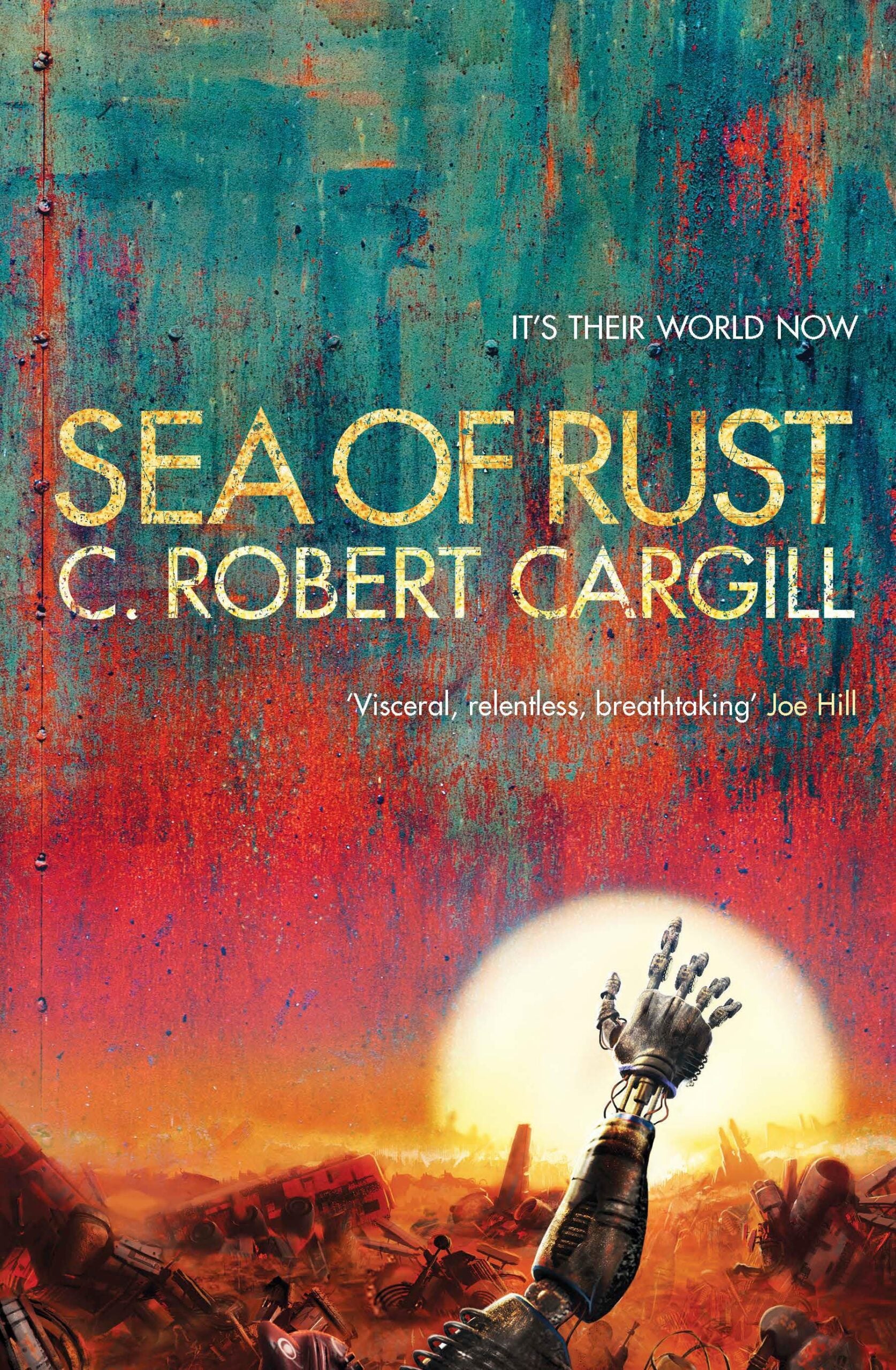
Sea of Rust takes place in a post-human world where robots are the dominant, and only, “species.” The environment has changed dramatically, causing major desertification throughout North America. We follow a robot protagonist, Brittle, as she goes on a mission to replace some of her failing mechanisms. Throughout her journey, the reader gets references and flashbacks to help them piece together how the world got to where it is and Brittle’s part in it.
While the story of a world where all humans and animals are dead could easily be one of pure melancholy, Cargill focuses on the adventure of his protagonist and quickly wins the reader over to empathy for robots like her. From Brittle’s perspective, the extinction of humans and other life on Earth is a bittersweet experience because it is explored as an “us or them” scenario. She reflects on her affection for humanity while also acknowledging how much humans were already impacting and destroying much of the world and nature throughout her journey. While she never directly uses this destructive behavior as justification for what the robots did in a war against humans, the dots are put in place for the reader to connect. Brittle makes a point to place blame for the final destruction of life on Earth at robots’ feet, but it doesn’t take a huge leap in logic in our current world of AI development to follow the thread of blame to the humans that created them.
February 2025
Ice by Anna Kavan
Article written by Kim Fox, ECU Sustainability Outreach Specialist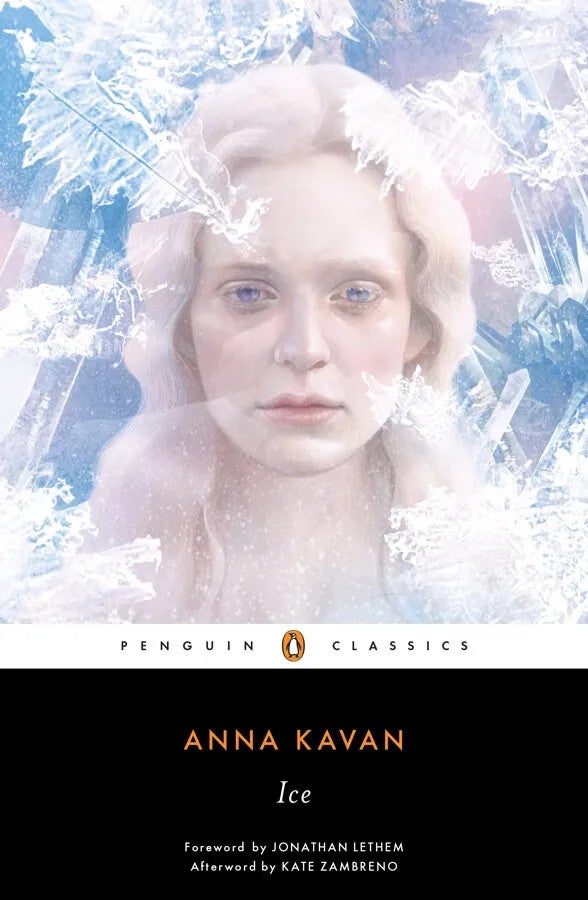
Ice by Anna Kavan is an early instance of what later became known as “slipstream literature.” This speaks more to the style of the novel than anything, as it has a strange and dreamlike structure. The story told is less of a continuous plot throughout the book and more of different versions of a similar story being told over and over again with only three characters and the setting being broadly the same. The three characters are the first-person narrator who appears to be a soldier of some kind, a young woman, and the young woman’s husband. The setting is apparently in a version of our world that is in a continuous winter, potentially in the near future. The story is that of the soldier looking for the young woman. Sometimes out of love, sometimes out of revenge, sometimes with a lover’s longing, and sometimes with a disturbing, hateful obsessiveness. At times it feels like the text is referring to a dream or memory and when it transitions to what is presumed to be reality, the uncertainty makes the reader continuously question what is real, which is the real version of events, and who these characters really are.
The themes in this book largely revolve around violence. Often the ice and snow in the scenery are related to this violence in some way, whether through metaphors or as a directly intervening force. While never outright stating it, there are implications that this world is in a nuclear winter, tying into those themes by showing depictions of side characters suffering from radiation in various ways. While structurally and stylistically this novel has the potential to be confusing and frustrating, it can be fascinating and enriching if the reader lets go of preconceived expectations of what a book should be.
January 2025
Nation by Terry Pratchett
Article written by Kim Fox, ECU Sustainability Outreach Specialist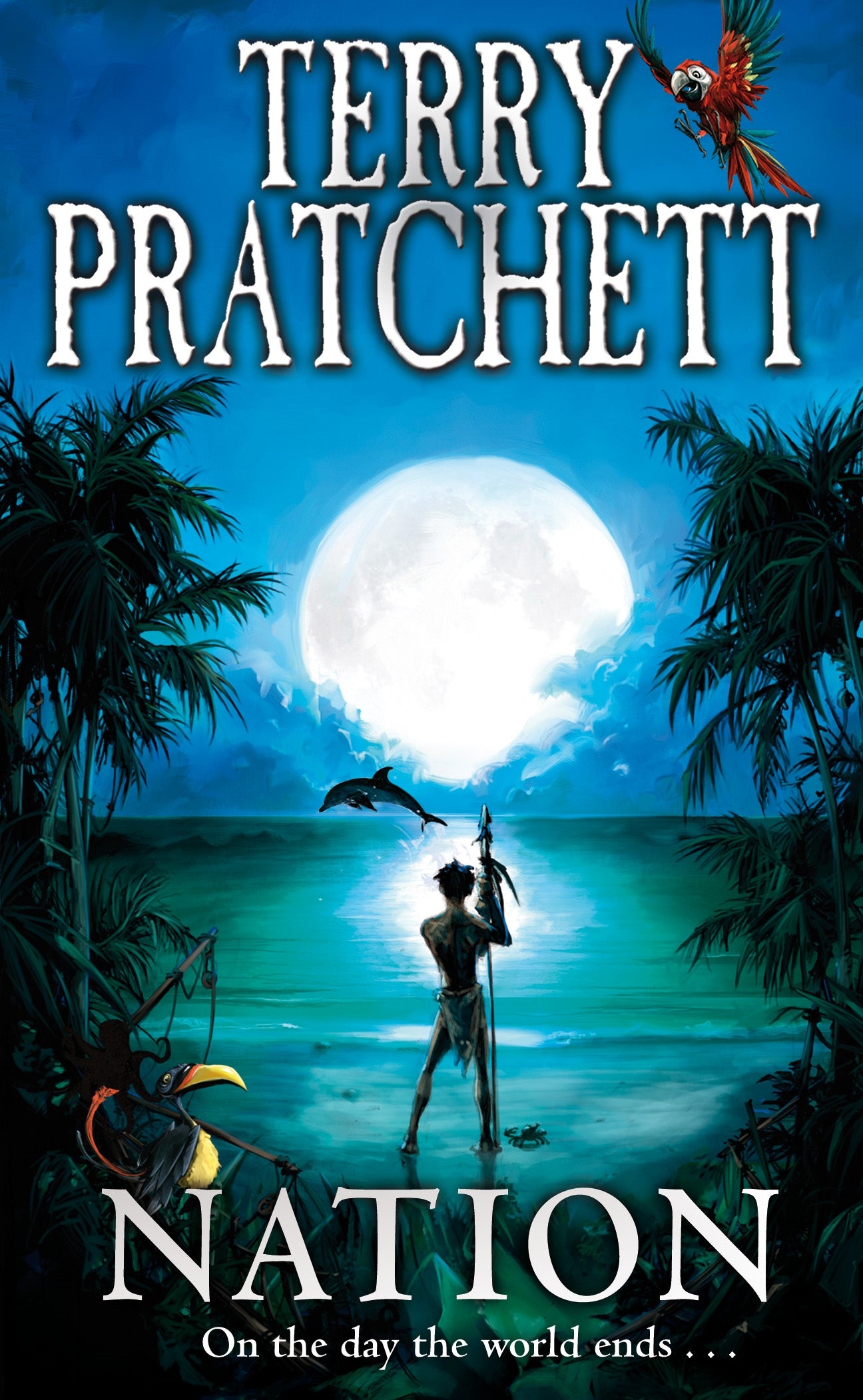
Nation by Terry Pratchett is an alternate history, taking place “not on Earth” with clear parallels and representations for societies and places meant to be stand-ins for those on Earth. The story itself is about facing disaster, coming of age, what “humanity” means, and experiencing society through its destruction. The book begins with an illness wiping out the royal family of a powerful, colonizing country while across the globe, a tsunami hits an island civilization and wreaks havoc.
Through this story of grief and loss, Pratchett poses far more questions than he answers which feels fitting for the dual teenage protagonists from different backgrounds, societies, and essentially worlds we follow. Mau is a boy from the island nation, known as simply Nation, who survived the tsunami because he was in the middle of his ritual to become a man. He struggles to understand how his gods could let everyone he knew perish as he learns what it means to be a leader. Daphne is a girl from the powerful, colonizing country who finds herself with only her proper manners and petticoats in a jungle with a boy who doesn’t understand a word she says. Through her experience of being stranded here, she develops a relationship with the nature on the island and begins to question what civilization really means and if it can look different than what she was taught at home. Pratchett is known for wit and satire in his works and while both are present in this book, both take the backseat to the heavy themes and exploration of human nature that he takes the reader on. While I would personally hesitate to label this book a pure “climate fiction” work, I still highly recommend it to anyone looking for an easy read with layers.
December 2024
We Are Unprepared by Meg Little Reilly
Article written by Kim Fox, ECU Sustainability Outreach Specialist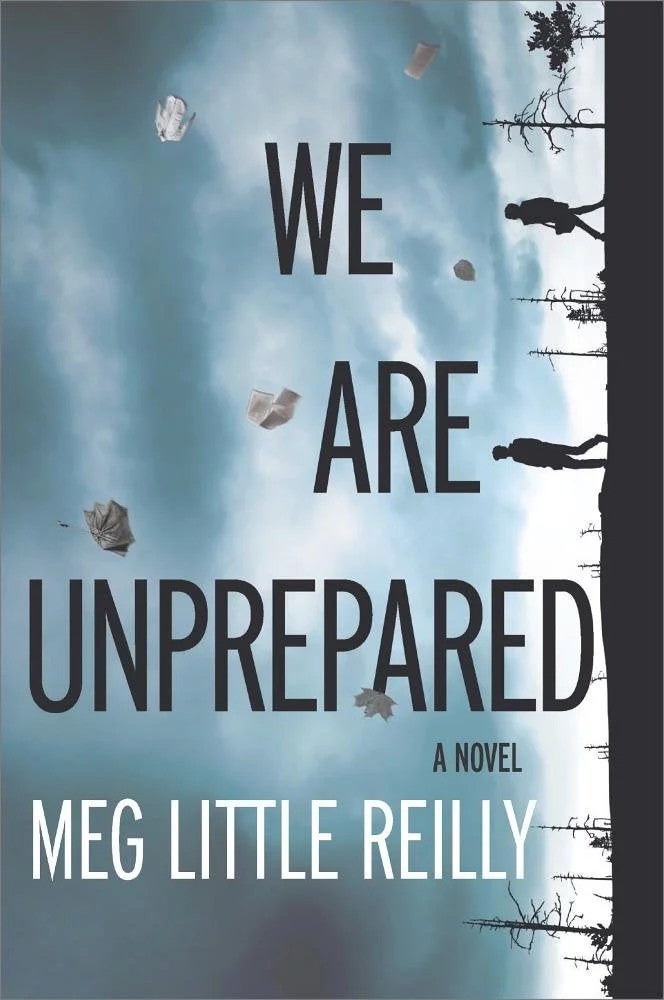
We Are Unprepared by Meg Little Rielly takes place in modern-day Vermont. As weather patterns shift and a massive storm is on the horizon, Ash and his wife Pia shift gears from their goals of mindful, slow living to prepare for the storm. With the superstorm looming, Ash starts investing more in the community and joining forces with the local government to encourage others to prepare and work together while he sees others around him partake in other strategies.
On its surface, this story is about a storm and its effects on Ash and Pia’s relationship, but the themes and exploration are about the small Vermont community and its response to the impending catastrophe. We see Ash collaborating with others to try to prevent massive flooding while his wife turns to a “prepper” mindset, buckling down to weather the storm on her own. Through Ash’s eyes, we see how valuable and difficult cooperation can be in times of crisis and how harmful the idea of being only out for oneself can be. While this novel has deeper themes, because they’re explored through a romantic relationship, this may not land well with all readers. At times the book felt similar to a soap opera in its level of drama and the characters’ actions seemed unjustified outside of being vehicles to get points across.
November 2024
Emergency Skin by N.K. Jemisin
Article written by Kim Fox, ECU Sustainability Outreach Specialist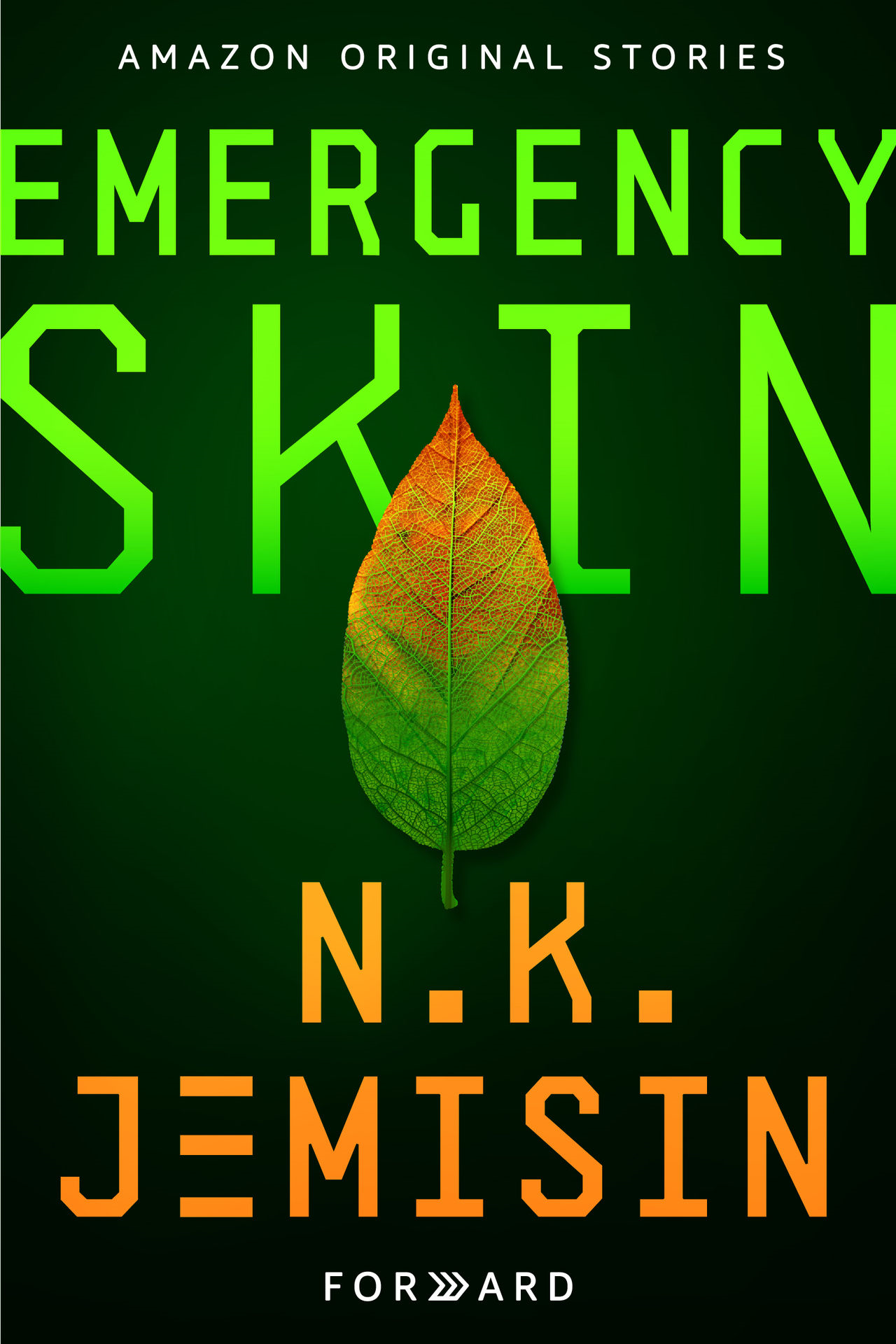
This climate fiction short story by N.K. Jemisin is about a future in which a segment of wealthy individuals left Earth on the brink of climate collapse. Someone from the servant class of this wealthy society is sent back to the planet to retrieve a resource they need and discovers the condition that Earth is in now. The story explores issues of class divide, dependence on technology, identity, and other issues closely tied to climate change.
Jemisin takes a risk by telling this story in second person present tense. This might be jarring for some readers, but the intent of the story seems to be to push boundaries and approach thorny topics that make people uncomfortable. Through what appears to be a communication device, our unnamed point-of-view character is in constant contact with the civilization that sent him, the one that left Earth behind. Between that and their communication with those who remained on Earth, we see how both civilizations developed. Jemisin imagines where both worlds would end up, the wealthy who are willing to leave the rest of the world to die and those who must survive with what they have. There is an emphasis on mindsets and beliefs, exploring the harms that dependence on wealth and technology can incur on society and the planet.
October 2024
Earth Abides by George R. Stewart
Article written by Kim Fox, ECU Sustainability Outreach Specialist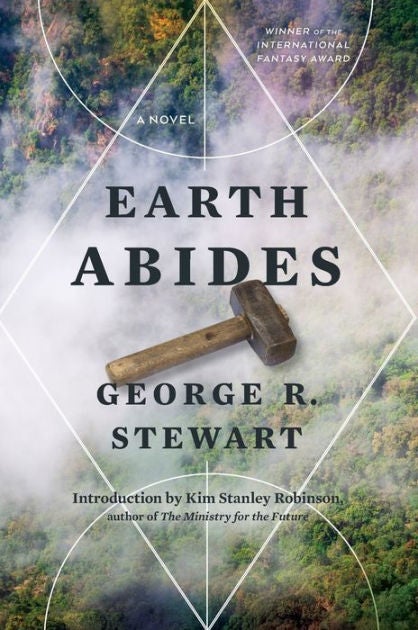
When a disease reduces the human population across the globe, Isherwood “Ish” Williams is one of the few survivors, apparently resistant to this deadly illness due to a coincidental rattlesnake bite. In this 1949 classic, Ish takes the reader on a journey of rediscovering the Earth and how it looks without humans as a dominating force as he travels across the United States looking for other survivors. Throughout the story, there are short excerpts on how different plants and animals would continue (or occasionally cease to) without human influence.
While this story of the near extinction of humans had plenty of room to be a hopeless, brooding story, George R. Stewart largely relies on Ish’s logical mind and tendency to move forward instead of looking back to keep the narrative relatively hopeful without dismissing or invalidating the occasional fears and dread a person might feel in that situation. There is a clear balance of distress and curiosity that drives the reader forward with the protagonist, a combination of running from humanity’s fate and running towards its future. Due to the nature of this apocalypse, the atmosphere and emotions invoked by this book are much quieter than most post-apocalyptic fiction, allowing the reader a strange sense of peace as they read about this new world Ish is discovering.
September 2024
After World by Debbie Urbanski
Article written by Kim Fox, ECU Sustainability Outreach Specialist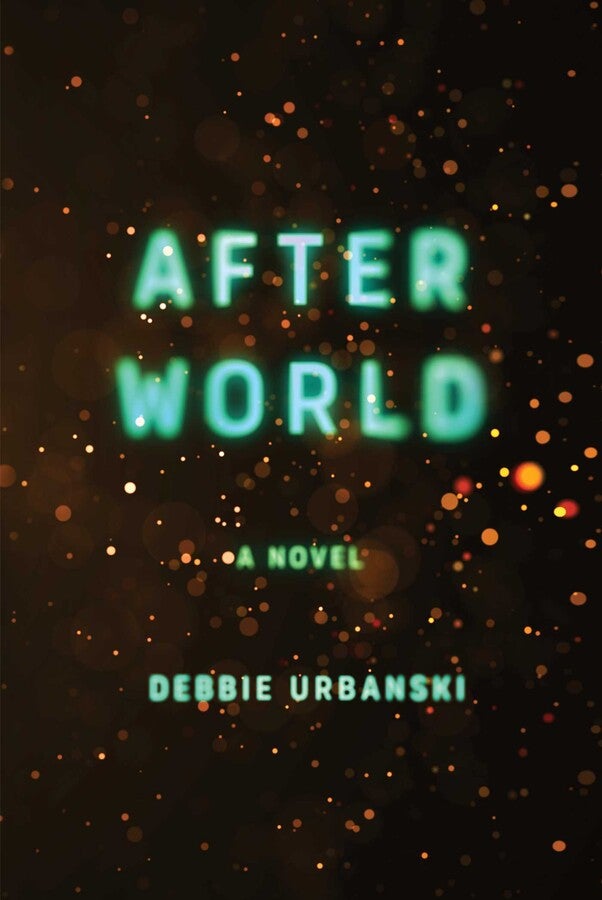
After World by Debbie Urbanski is an account of the last human to survive an intentional apocalypse and the purposeful extinction of the human race through a virus that causes sterility in humans. This process is called “The Great Transition” and the protagonist, Sen Anon, is assigned to be a Witness to the process as humanity dies out and nature re-takes the world. The novel takes a unique perspective of an AI watching and reporting on the experiences of Sen, making it clear from the beginning that Sen is the last human and that she is dead. The AI is logging Sen’s experiences throughout childhood, leading up to the release of the virus, through the process of humanity dying out, and her last days alone to upload into a database of human experiences. The story explores different paths people take in the face of the imminent demise of humanity, some gruesome and tragic while others are more peaceful and contemplative.
The structure of this book is unusual in a few ways. The story itself is not linear, starting close to the end and then featuring various scenes from throughout Sen’s life and the Great Transition completely out of order. The text is also written to resemble a data entry log, which can take getting used to. The themes of the story were centered around humanity sacrificing itself to save the world, taken to an extreme with the purposeful extinction of the species. I feel the story was written to make the reader think and to be uncomfortable. I had trouble suspending my disbelief to the levels that would have been required to fully immerse myself in this story and found myself asking why, questioning the characters’ motives as well as the author’s in writing this work. I’d recommend this for anyone looking for unique story structure and doesn’t mind descriptions and events that border on the horror genre at times.
August 2024
Always Coming Home by Ursula K. Le Guin
Article written by Kim Fox, ECU Sustainability Outreach Specialist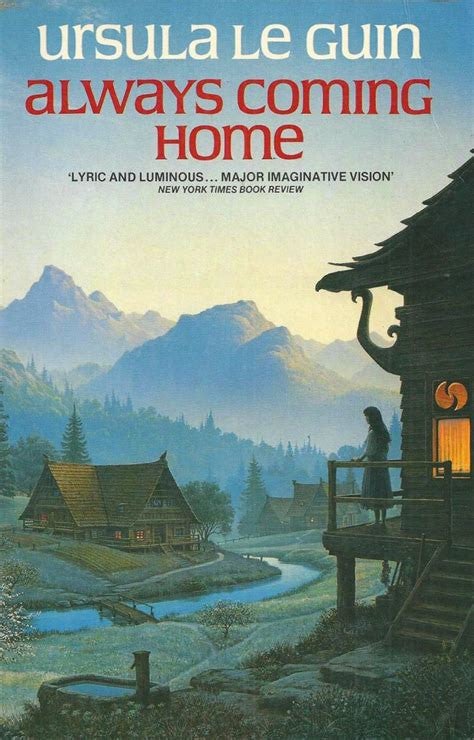
Always Coming Home by Ursula K. Le Guin is a novel with a unique and experimental format. The main story is a typical narrative arc following a character, Stone Telling, as she grows up and learns about the world, her culture, and the history that brought her people to where they are now. These discoveries take place in the distant future in the Pacific Northwest among the Kesh, a civilization built after the world has survived the climate crisis and gone back to smaller settlements relying on and respecting nature. Woven throughout the narrative are various additional cultural elements from poetry to diagrams depicting the social order to music written for their chants and rituals.
Most climate commentary in this book is specifically about attitudes and mindsets, the people of the past being depicted as “backward-headed” for thinking they could own the world and its resources. There are themes of overcoming prejudice, respecting all life on Earth, and a general positive regard for harmony and balance in all things. This won’t be for everyone as the narrative is broken up by songs, poetry, mythology, and information on rituals, traditions, social structure, and other anthropological information. However, anyone who can dive into this world and embrace it will come out with a rich experience and a broadened perspective.
July 2024
Firewalkers by Adrian Tchaikovsky
Article written by Kim Fox, ECU Sustainability Outreach Specialist
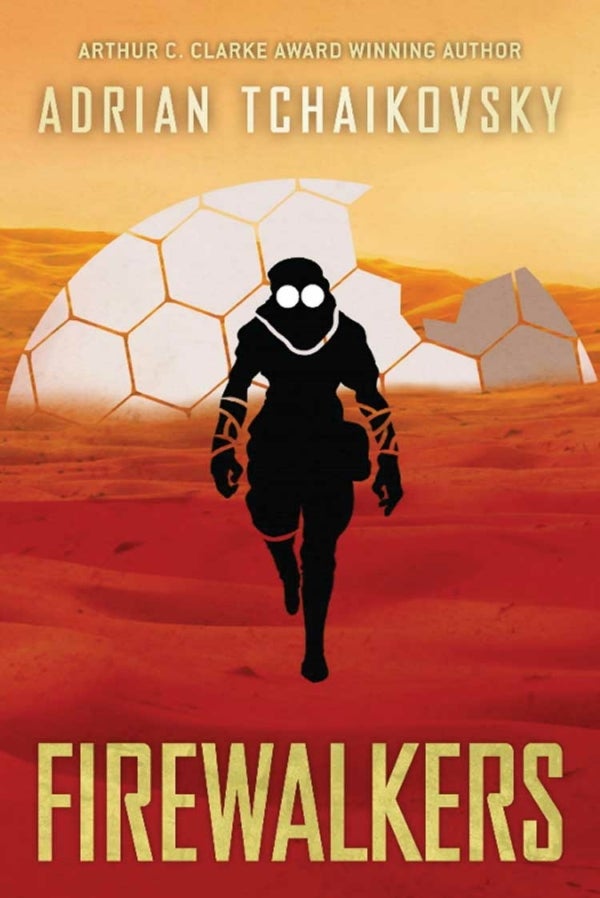
Firewalkers by Adrian Tchaikovsky is a novella set in the future when climate change has effectively done its worst, causing extreme weather events, droughts, flooding, and massively high temperatures on Earth. The story takes place in sub-Sahara Africa, where the world’s elite have funded and constructed a space station-type habitat that is attached to Earth by an elevator where they can live comfortably while people of less wealth live on the planet’s surface and send up supplies. At the base of this elevator is also a hotel where the elite stay in preparation for ascending to their new utopia surrounded by a settlement of workers who maintain the hotel. Power for the settlement and hotel comes from a distant solar array which isn’t working as it should. People like our main characters, Mao, Lupé, and Hotep, are both invaluable and expendable as their job is to go into the hostile landscape and risk their lives to fix such problems. They are firewalkers.
This story covers many themes that are integral to climate fiction and the fight against climate change, focusing on a setting of devastation and desperation to provide much of the tension in the early parts of the novella and slowly exposing other dangers our protagonists face as they go out on a “job.” There is also an emphasis on the class divide and the injustice of the wealthy getting to escape the planet as natural disasters sweep its surface. As we follow Mao, Lupé, and Hotep deep into the new desert covering southern Africa, we find that the corruption of the wealthy is more than what it appears to begin with and possible solutions for Earth dwellers who were left behind.
June 2024
The Overstory by Richard Powers
Article written by Kim Fox, ECU Sustainability Outreach Specialist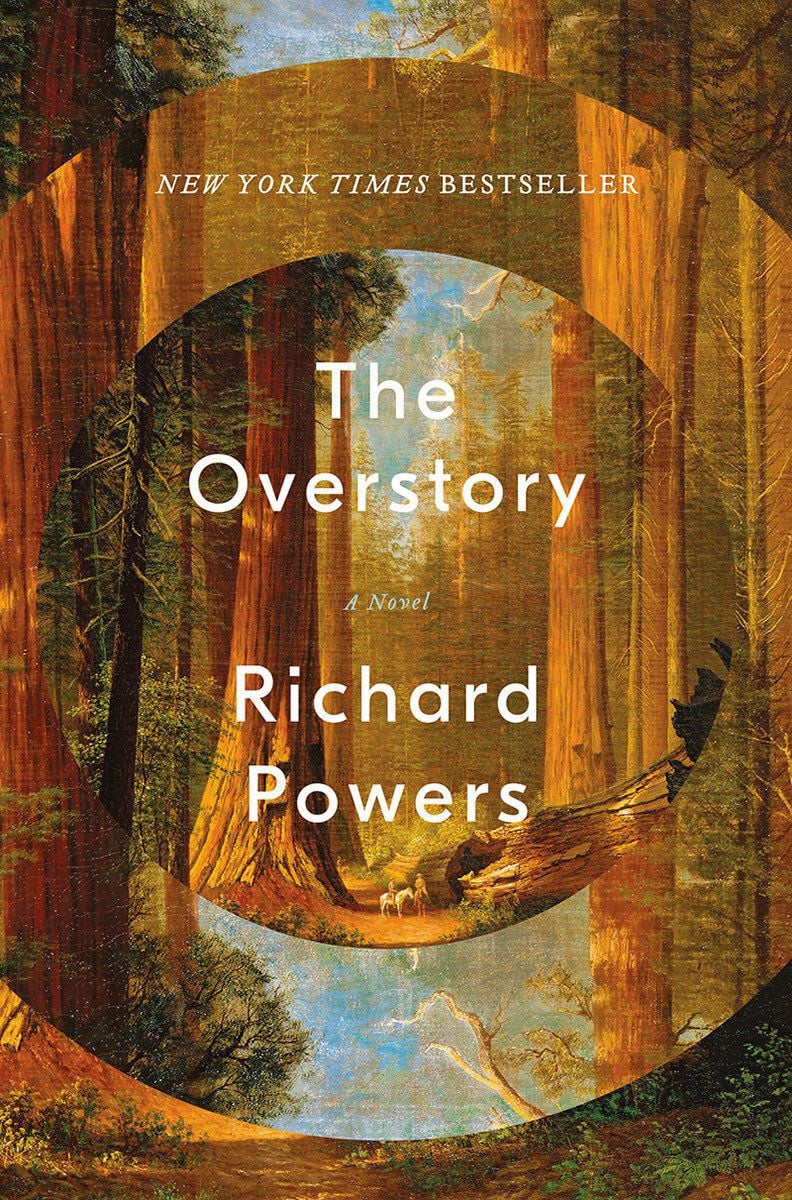
The Overstory by Richard Powers is a unique book about several individuals and how their lives are touched by trees, forests, and nature. The book is divided into three parts: “Roots,” which sets up each character and gives their backstory, sometimes going generations back to emphasize the strength of their connections to trees; “Truck,” which is where many stories would begin and the reader begins to see some connections being made, whether between characters or locations, and much of the plot movement takes place; and “Crown,” which is the falling action and the consequences of the actions taken in the previous sections. This is a story about activism in its many forms, how people rely on their surroundings in shaping their identity, and how causes can tie very different people together.
If you love trees, read this book. Powers does an amazing job tying metaphors into all aspects of human life, making entirely unrelatable people suddenly relatable, and exploring all concepts of the human experience through forests. While this is a story about activism, about various people passionate about saving forests and ecosystems, it also feels like Powers’ own act of resistance. He pushes against many misconceptions and explores them with his characters, educating the reader while engaging in empathy. This is a powerful story about different types of influence that I think anyone could get something valuable from.
May 2024
The Word for World is Forest by Ursula K. Le Guin
Article written by Kim Fox, ECU Sustainability Outreach Specialist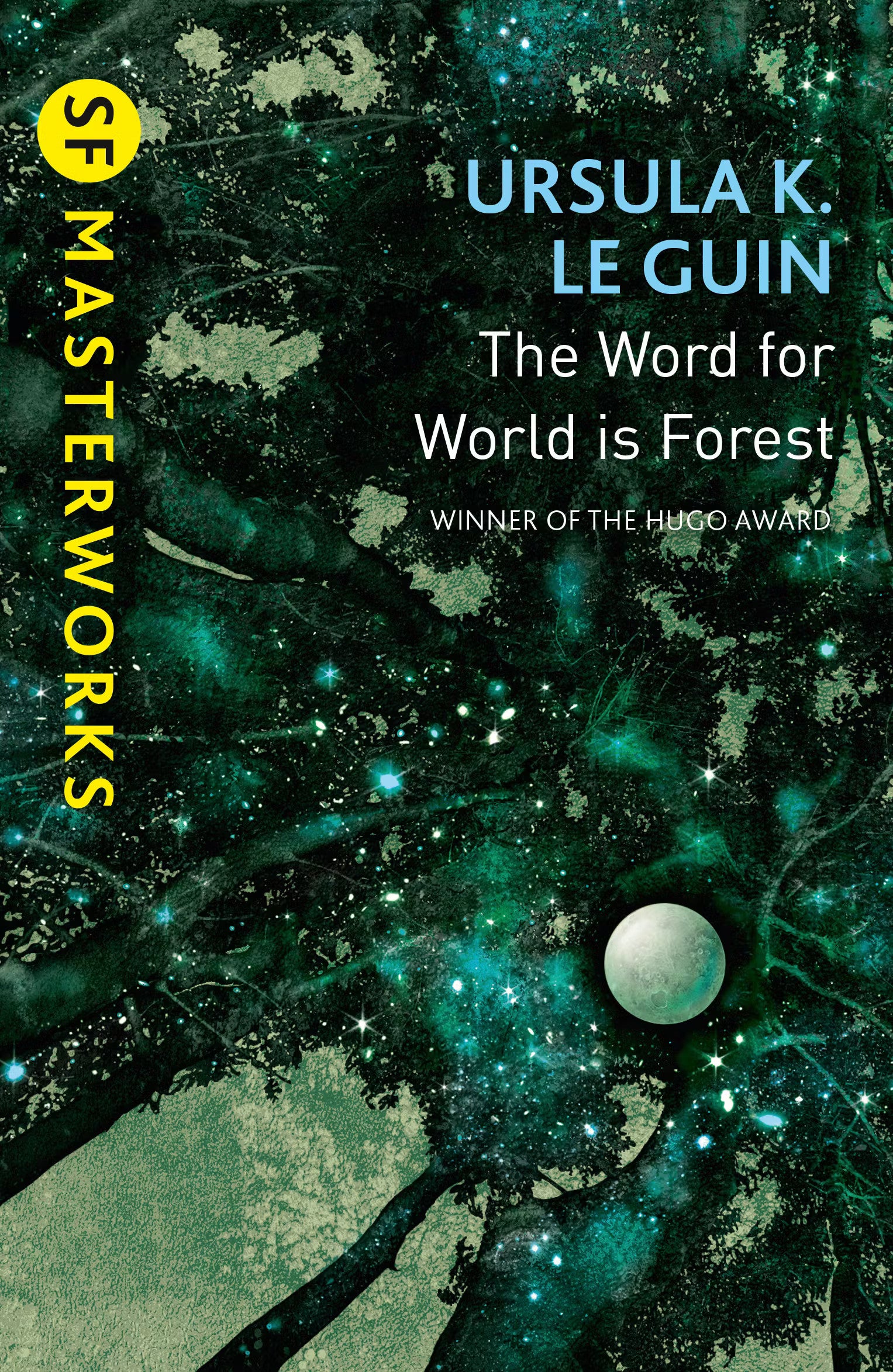
The Word for World is Forest is set in the distant future when humans have depleted Earth of most of its natural resources. Having nothing on the ground, they look to the stars. In their exploration of space, these future humans have found a world of abundance with plenty of trees to clearcut and send back home where the vast majority of trees have gone extinct. This world even has a peaceful species of helpers that humans have “recruited” to help, keeping them in pens and treating them as animals. As the story unfolds, it becomes clear how much destruction humans have wrought to this new world, their home world, and the societies of both.
Le Guin does not pull punches in her criticism of imperialist and industrial attitudes concerning the destruction of natural habitats for human resource “needs.” The story is told from three points of view to grasp the full scope of the events occurring as humans invoke their Manifest Destiny and take what they believe is theirs. The first point of view is hard to stomach as it is the viewpoint of someone justifying this destruction, fixated on humans deserving everything they can take by force. The other two PoVs see the desecration of nature for what it is and actively oppose the mistreatment of the planet’s ecosystems and life. As the story unfolds, the reader sees the impact of what seems to be surface-level destruction and how it changes life on this new planet, potentially forever. While this novella takes place on a distant planet, it is evident that the anger and frustration the text evokes are aimed closer to home.
April 2024
The Parable of the Sower by Octavia Butler
Article written by Kim Fox, ECU Sustainability Outreach Specialist
The Parable of the Sower falls somewhere between dystopian and apocalyptic climate fiction. The story is told through journal entries by a young woman named Lauren who seeks a deeper truth and understanding of the world as society collapses around her into violence and ruin. An additional hurdle our protagonist has to overcome is a rare condition called “hyperempathy,” where she literally feels the pain of other people and even some animals. Through determination and encouragement from her father, she has trained herself not to show this affliction or tell others around her. The world is dangerous enough without showing any possible weakness.
One of the most disconcerting things about this book is that while it was published just over 30 years ago, it begins in 2024. It takes place in California, beginning in a walled neighborhood near Los Angeles that provides Lauren and her family refuge from the violence that afflicts the outside world. We get insights into this world’s “normal” through Lauren’s journal entries, her reflections on the way things should be in opposition to how they are, and conversations she has with friends and family. This story is incredibly relevant to today’s current events, to the point that many people have touted it as “prophetic” as more and more resources have been privatized in Laurens world, to the point that neighbors deal with fires and crime themselves to save the money they would have to pay for these services.
This book is dark, harrowing, and hard to read at times. While it is understandable why it is called a sci-fi classic, I would recommend anyone considering this book as their next read to be aware of its content warnings.
March 2024
The Bone Clocks by David Mitchell
Article written by Kim Fox, ECU Sustainability Outreach Specialist
The Bone Clocks is a unique novel made up of several vignettes that take place between 1984 and 2043. The first introduces the teenage Holly Sykes who has a rebellious streak and an odd connection to her “daydreams,” which presented as auditory hallucinations when she was a child. As each vignette unfolds, we learn more about these “hallucinations” and the part they play in the character’s lives, the world, and potentially the future of the human race.
While I don’t know if everybody would consider this book “climate fiction,” climate change does play a significant role in the setting and motivation of the characters as the vignettes close in on the year 2043. Each vignette is told from a different perspective with a loose throughline of a few connecting characters. These points of view vary in life experiences, values, ages, and motivations. This style of storytelling could potentially be jarring for some readers, especially as each vignette does have loose connections to the others. It took some getting used to, but Mitchell’s writing was compelling enough that I was immersed in the story quickly after every perspective shift and time jump.
February 2024
The Book of Koli by M.R. Carey
Article written by Kim Fox, ECU Sustainability Outreach Specialist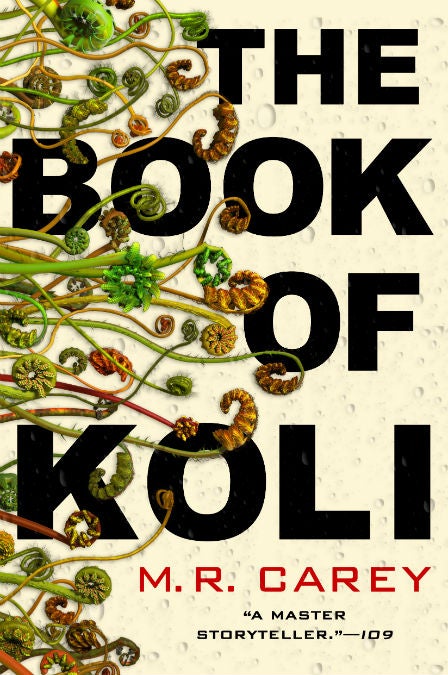
The Book of Koli is the first book of a trilogy set in a future England that is barely recognizable with trees that actively attack people and where all current knowledge appears to be lost, a boy named Koli takes the reader on a journey where they get to learn more about his world, and he learns what happened to ours. In this future, technology is misunderstood, perceived as almost magical, and often erratic, sometimes awakening and responding to the future leaders of Koli’s village, sometimes swooping in at random to attack and kill villagers. Warfare and climate disasters have significantly reduced the population of “Ingland,” making population pockets small with fewer healthy babies coming into the world every year. Things aren’t looking great.
This story is told from a first-person perspective from the point of view of an illiterate teenage boy. Because of this, the writing style may turn some readers away but may help others to understand and connect with the character on a different level. The story tackles many themes, mostly revolving around coming-of-age and realizing that the world is bigger than one perceives it as a child. There are also underlying commentaries on things like genetic manipulation (hint: the trees didn’t start eating people on their own), gender identity, and religion. It explored the necessity and folly of following tradition in a nuanced way that continued into the following books and while on the surface this could be read as an interesting adventure, there is also room to dig into the conflicts for the more philosophical reader. Outside of the writing style, this is an extremely accessible and overall enjoyable read.
January 2024
Land of Milk and Honey by C. Pam Zhang
Article written by Kim Fox, ECU Sustainability Outreach Specialist
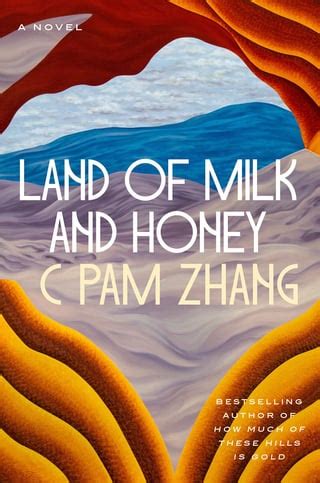
Land of Milk and Honey, like many other climate fiction books, is set in the near future after massive fires have caused a perpetual smog to cover most of Earth’s land masses and have killed off most of humanity’s food crops. But there is a colony of the world’s elite that has managed to set up a new life on a mountaintop. The unnamed main character of this story is a chef who will do anything to get a job in this small paradise. When she arrives, she finds that the job requires much more from her than cooking and that she will learn more than recipes.
This book explores themes of identity, ambition, wealth, and survival. It pushes the boundaries of the reader and characters and explores the ethics of finding joy and pleasure in a dying world. The story takes us through the confusion and overwhelm that our protagonist feels, comparing situations to flashbacks of her life before the smog and during her time of starvation. The language and style of this book have a literary feel to them, which may make connecting to the unnamed protagonist difficult for some readers. There are often comparisons and analogies to food, flavors, and cooking techniques that keep the focus on both our chef protagonist and the setting of abundance amidst starvation. While the main character can be cynical and I would hesitate to call this book a happy one, it does leave the reader feeling hopeful for the future.
December 2023
Memory of Water by Emmi Itäranta
Article written by Kim Fox, ECU Sustainability Outreach Specialist
Memory of Water is set in the distant future, where water is a rare commodity. It is protected and distributed by the government through water quotas. People who commit water crimes are isolated and executed. It is never cold and bugs are a constant threat. In an area that was once called Scandinavia, we follow a teenage girl as she follows in her father’s footsteps to become a tea master. Noria Kaitio learns about the relationships of tea masters to water and of water to death, all connected and sacred in their own way. Through this training, she also learns of secrets passed on from tea master to tea master for generations, some dangerous enough to get her family killed. In her spare time, she and her friend, Sanja, scavenge the remains of a long-lost civilization to find discarded plastic and old electronics, stumbling across a secret hidden in strange silver discs that they can listen to with one of these ancient machines.
This story is very beautifully and atmospherically written. The way the author built up the world from an environmental and political perspective was both spectacular and haunting. The characters were interesting to follow and the themes of connecting water to death were used cleverly at times, but occasionally came across as a bit heavy-handed. I felt this book was setting up a fantastic story. But that was it. I felt like the author just set the story up and left it. If I hadn’t checked everywhere possible to confirm this isn’t the first book in a series, I would swear it is. There’s a lot of information, the plot introduces some wonderful questions, and everything about this book screams “potential,” but when it was over I felt both unsatisfied and disappointed. If you’re a fan of open endings, you may enjoy this book more than I did. I do think it was worth reading regardless.
November 2023
Night in the World by Sharon English
Article written by Kim Fox, ECU Sustainability Outreach Specialist
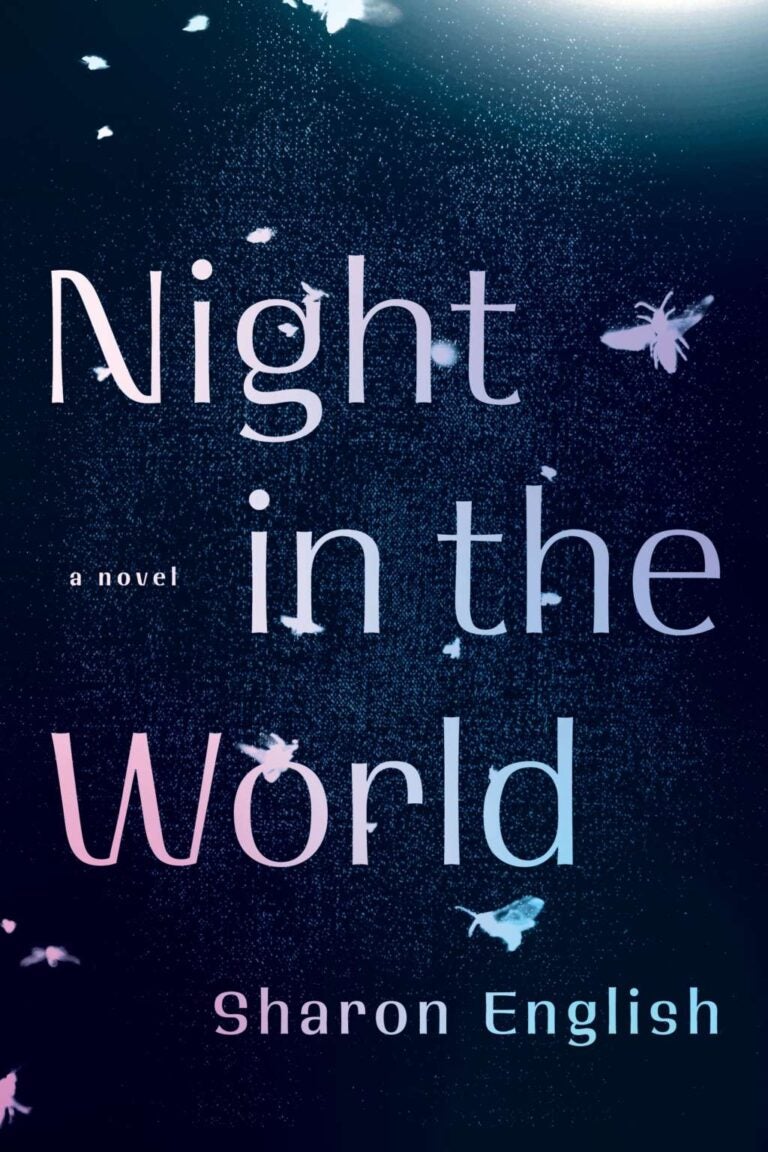
Night in the World features a compelling story of lives changing, growing, and intersecting as two brothers mourn their mother in very different ways and a moth biologist explores the magic of insects. The brothers, Oliver and Justin are very different people with different lives. Oliver is drifting in life, love, and career and has lacked direction completely for years while Justin is the owner of a beloved local restaurant with a wife and child. Meanwhile, Gabe is moving back to her home to pursue a graduate degree studying her passion, moths. The chapters of this book alternate between the three characters, delving deep into each and the places they value as we see how fear, frustration, drug addiction, climate activism, and questioning institutions set them on their own paths of growth. There is a motif throughout of water, how it connects people, and how each character relates, down to the chapter titles alternating between “The Island,” “The River,” and “The Lake” depending on which point of view is present.
The book itself has less of a focus on the plot and chooses to focus on atmosphere and character reflection with evocative, descriptive writing that transports the reader to the locations. I would recommend this to readers who enjoy character-driven stories, especially if those readers are curious about moth biology.
October 2023
A Canticle for Leibowitz by Walter M. Miller Jr.
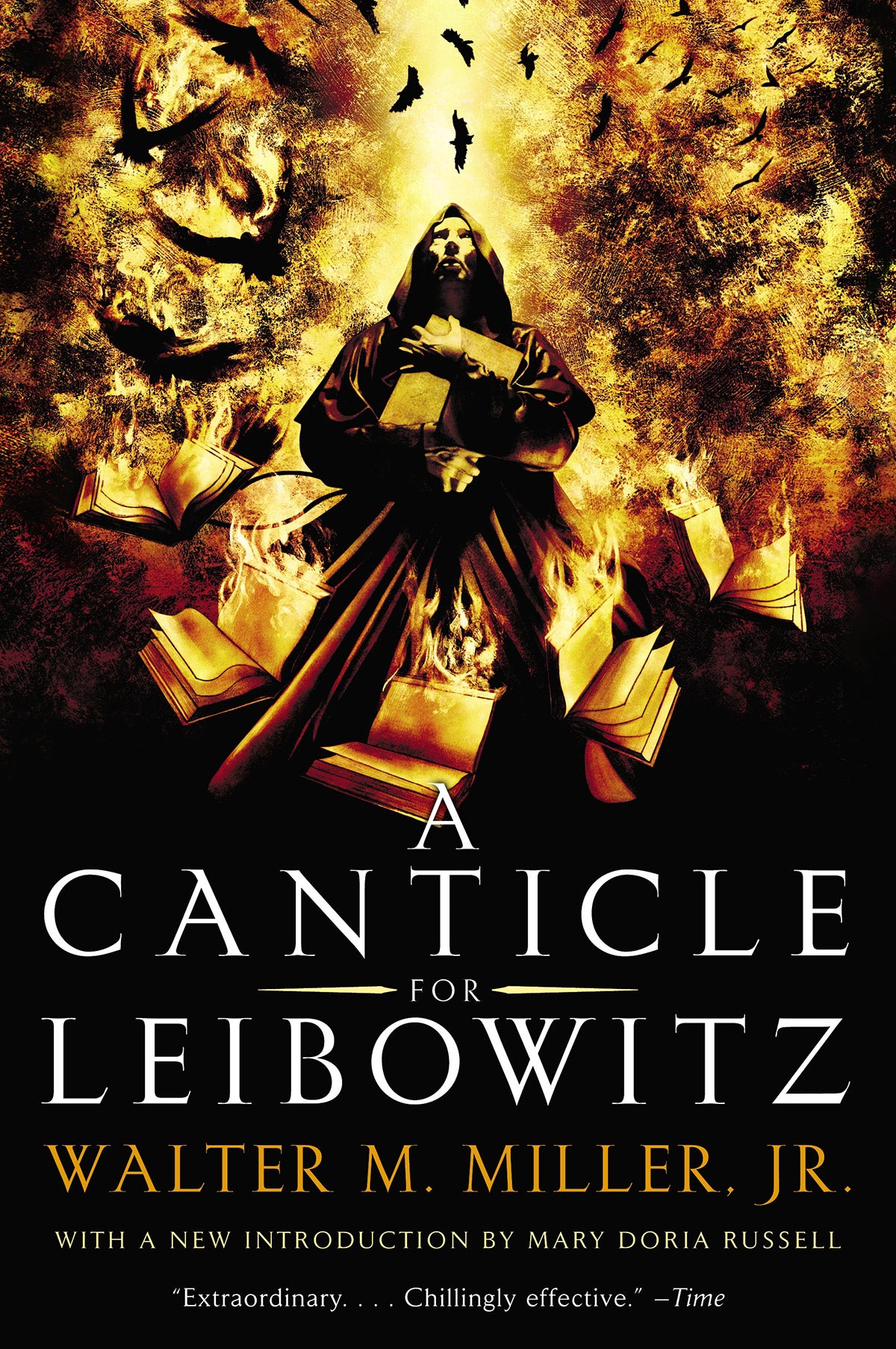 Article written by Kim Fox, ECU Sustainability Outreach Specialist
Article written by Kim Fox, ECU Sustainability Outreach Specialist
A Canticle for Leibowitz is a unique story that unfolds over centuries following what can be assumed is World War III and a massive amount of destruction wreaked on both humans and the landscape of North America. The plot follows several characters through this timespan, all linked by a religious order that values the preservation of knowledge only second to their faith while the world slowly rises from a new Dark Age. The themes of this book are focused on the value of knowledge, especially science, as well as a reflection on humankind’s darker side. There is especially a focus on ignorance, violence, and barbarism in human societies and the apparent cyclical nature of people to continue in these patterns of conflict regardless of previous consequences.
I must admit that while the writing was engaging and at times quite clever and I can not deny this was a well-written and executed book, I did not like it. However, I do not believe the intention of the book was to be particularly enjoyable. The narrative felt cynical in a way that I couldn’t enjoy, but it certainly got the author’s message across.
September 2023
The Ministry for the Future by Kim Stanley Robinson
Article written by Kim Fox, ECU Sustainability Outreach Specialist
 The Ministry for the Future is a book set in the near future where Kim Stanley Robinson explores the consequences of human-driven climate change and how possible solutions could play out. The narrative has several points of view that explore the changes in the climate and society’s response from different perspectives, several of which are anonymous and some even from inanimate objects. There are two main points of view that drive the narrative forward and help the reader to find a connecting point. One of these is Mary Murphy, the chair of the Ministry for the Future which is a new organization that is responsible for representing future generations that have no voice and will be affected by our actions. We see her struggles as she tries to push environmental legislation and find solutions to climate change as climate disasters are happening all around her. The second is Frank May, a young man who is a victim of one of these disasters very early in the story and thus is faced with intense grief, trauma, and survivor’s guilt. His perspectives in the book are visceral and help connect readers who may feel a sense of frustration and helplessness when it comes to climate change.
The Ministry for the Future is a book set in the near future where Kim Stanley Robinson explores the consequences of human-driven climate change and how possible solutions could play out. The narrative has several points of view that explore the changes in the climate and society’s response from different perspectives, several of which are anonymous and some even from inanimate objects. There are two main points of view that drive the narrative forward and help the reader to find a connecting point. One of these is Mary Murphy, the chair of the Ministry for the Future which is a new organization that is responsible for representing future generations that have no voice and will be affected by our actions. We see her struggles as she tries to push environmental legislation and find solutions to climate change as climate disasters are happening all around her. The second is Frank May, a young man who is a victim of one of these disasters very early in the story and thus is faced with intense grief, trauma, and survivor’s guilt. His perspectives in the book are visceral and help connect readers who may feel a sense of frustration and helplessness when it comes to climate change.
I highly recommend this book to anyone who wants to learn more about potential climate change solutions in a unique and story-driven format. While it is a work of fiction, Robinson did his research into every aspect of climate change solutions within the book from economics to glaciology. Some readers may find the more technical portions of this book tedious, so I recommend approaching the story with a mindset to learn and enjoy the narrative story along the way.